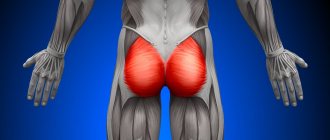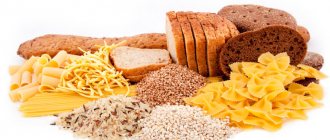Classification and structure of fats
From a biochemical point of view, fat molecules are classified as acids and are divided into two main types: saturated and unsaturated.
Natural fats are heterogeneous in their chemical composition; their physical properties and taste are largely determined by the different ratios of the saturated and unsaturated fatty acids they contain.
Saturated fats
Saturated fats (saturated acids) are simple in structure, in them the bonds between carbon atoms are saturated to the limit, so they are inactive from a biological point of view.
| Most saturated fats are not completely absorbed by the body (80-90%). The higher the saturation of fat, the more likely it is to remain in the body (in the circulatory system). |
Saturated fats in excess amounts can increase total cholesterol levels due to the simultaneous increase in both “bad” and “good” cholesterol, so it is important to observe moderation in their consumption (for recommended amounts, read the section “Issues of eating fats”), avoid you can't avoid them completely.
As a rule, these fats are solid at room temperature (lard, oil), with the exception of two types of vegetable oil - palm and coconut.
Unsaturated fats
Unsaturated fats (acids) contain one (monounsaturated) or more (polyunsaturated) “fragile” bonds in the molecule, at the site of which hydrogen can attach; they react more easily with other substances.
| Unsaturated fats have a low melting point. They are absorbed in the body much more easily than saturated ones and perform more important functions. |
Monounsaturated fats increase good cholesterol levels and also contain omega-9 fatty acids (oleic acid).
Oleic acid is responsible for the permeability of cell membranes, which decreases with its deficiency, therefore, metabolism is also disrupted. Olive oil, for example, is rich in oleic acid.
Polyunsaturated fats contain Omega-3 and Omega-6 fatty acids.
Omega-3 are polyunsaturated fats that are not reproduced in our body independently (they are essential), but play a vital role.
Omega-3s are introduced into cells and affect their structure and activity. Hence their variety of beneficial properties: they improve the functioning of the heart, brain, eyes and joints, and reduce the level of “bad” cholesterol in the blood. These fats reduce inflammation, play a role in lowering blood pressure, and are excellent antioxidants. Omega-3 fatty acids are especially important during pregnancy and breastfeeding.
Sources of Omega-3: flax and chia seeds, salmon, walnuts, Chinese cabbage.
Omega-6 fats are also essential. They are necessary for the growth and synthesis of compounds such as hormones, to protect the body from many diseases (heart disease, various forms of allergies, cancer, premature aging, etc.).
Sources of Omega-6: sunflower seeds, poppy seeds, sesame seeds, walnuts, soybeans, corn and their oils.
With a deficiency of Omega-3 fatty acids, Omega-6 fatty acids exhibit properties opposite to their positive ones. Therefore, the balance of these fats in the food entering our body is important. Omega-3 and Omega-6 should be consumed in certain proportions - recommended ratios range from 5-10:1 Omega-6:Omega-3.
| To meet the physiological needs of an adult (5-10 g/day Omega-6 and 0.6-1.6 g/day Omega-3), for example, you can consume 1-2 teaspoons per day of flaxseed oil, which is the most balanced in terms of Omega-3 and Omega-6 fatty acids. |
It is important to know that Omega-3 and Omega-6 fatty acids are highly susceptible to oxidation. When fats are heated and exposed to air, oxidation occurs faster.
| WHO experts say that unsaturated fats are preferable to saturated fats. However, the body needs both saturated and unsaturated fats to function properly. |
Trans fats
Industrial trans fats are formed when unsaturated fats harden (hydrogenate). Ultimately, liquid vegetable oils are converted into solid oils such as margarine, spread, soft butter mixtures or shortening.
These types of fats are widely used in the food industry, including to extend the shelf life of products. It is a common practice to add trans fats to increase the fat content of curd masses, processed cheese, ice cream, etc.
Minor amounts of trans fats can be formed when oils are heated for long periods of time during frying at high temperatures.
| WHO states that industrial trans fats are not part of a healthy diet. They are very harmful and you should not eat such fats. |
Trans isomers , which are formed during the process of hydrogenation, harm the hormonal and enzyme systems of the body, promote the accumulation of toxins, and increase the risk of developing many diseases - from atherosclerosis and obesity to diabetes and cancer.
Industrial trans fats in a product can be identified on labels by the words “hydrogenated” or “ partially hydrogenated” . However, the absence of these words does not guarantee that there are no trans fats in the composition.
Small amounts of naturally occurring trans fats are found directly in some meat and dairy products (eg, beef, lamb, butter). The composition of natural trans fats differs from industrial ones. There is not yet enough research to answer the question of the effect of natural trans fats on the human body.
The main sources of all described groups of fats are presented in the infographic:
| Saturated fats are often attributed numerous harmful properties, confusing them with trans fats. The differences in their effects are shown in the table. |
The effects of saturated fats and trans fats on various systems and changes in the body
Review of liposuction of the abdomen and sides
Below I quote the full text of my patient’s review, which she left on the plastic surgery portal about her liposuction surgery on the abdomen and sides:
Plastic surgeon: Svetlana Nikolaevna Zharkova, Moscow
12 Dec. 2021, 17:14:14, Larisa
Operation: Liposuction
I would like to write a kind review about my transformation thanks to Svetlana Nikolaevna Zharkova.
The liposuction surgery of the abdomen, sides and inner thighs was performed on October 1, 2021.
I will share the results with you a week and a month after the operation. I will also tell you about my recovery process.
Everything happened quite quickly for me.
Liposuction surgery for 10 zones - from preparation to discharge
The day before on Friday, I came for a consultation specifically in the morning to immediately take all the tests, and on Monday I was already on the operating table. From Svetlana Nikolaevna’s side, everything was organized clearly, comfortably, at first sight we found a common language, I trusted with absolute trust and calmness put yourself in her golden hands!
From Svetlana Nikolaevna’s side, everything was organized clearly, comfortably, at first sight we found a common language, I trusted with absolute trust and calmness put yourself in her golden hands!
Due to the fact that liposuction was performed on 10 zones, general anesthesia was chosen. I’ll be honest, what happened to me personally: I felt pain for the first and only time only after the operation for 30 minutes: the pain was unbearable, since the operation lasted 2.5 hours - I was frozen on the operating table (I was completely naked in order to maintain complete sterility), and when they brought me to the ward, the painkiller had not yet had time to take effect, to speed up they put on an IV - during these 30 minutes I was shaking terribly, shivering, because of this my body, namely my muscles, tensed, because of this there was a spasm in places where fat has just been removed. This made the pain very clear. As soon as the painkiller took effect, that’s it, the pain disappeared and I never experienced it again.
I would like to note the work of a very sensitive, kind, attentive nurse. I'm very sorry, I didn't remember her name, but her care was priceless!
The painkiller was administered intravenously twice more: before bedtime and in the morning. Then I only drank ketans twice, not because it hurt, but rather out of fear of feeling pain. But again, she was no longer there. On Monday the operation was performed, on Tuesday I was discharged under the supervision of Svetlana Nikolaevna, and on Wednesday I was already on the Sapsan going to St. Petersburg.
By the way, I didn’t write, 3.5 liters of fat were pumped out of me, the parameters changed dramatically, but the weight did not, only after a month it gradually began to decrease. This is fine.
Rehabilitation period - sensations after liposuction, procedures
During the first week, body movements were neither easy nor difficult, something in between. It was easy to move in one position, but it was uncomfortable to change it: when sitting, stand up; when standing, lie down. But I would compare all these sensations to the pain that happens after the gym, when you overdo it with dumbbells after a long break. A week later, I came for a follow-up examination at the clinic and then we kept in contact with Svetlana Nikolaevna via WhatsApp.
A week after the operation, I completed a course of five magnetic therapy procedures, then switched to LPG massage, also 5 procedures due to lack of time, I flew away. Of course, I would have done that 10. It wonderfully breaks up seals (which are a natural consequence of surgery, they go away on their own anyway, just massage speeds up this process), tightens the skin, reduces volume, relieves swelling, and so on. There are many advantages. Then I started visiting the pool and that’s where my “exercises” ended) I would like to note the presence of bruises, of course everyone has different things, for me it’s like this: the bruises were on the back and on the inner surface of the thighs - they all went away completely after a month. I will also attach to the report a photo with the remaining mark on the thigh (as an example) from a cannula puncture a month later. It looks more like a mark from a ripped off pimple))
My wishes to those who are just thinking about liposuction
In conclusion, I would like to say: do not be afraid! This operation and subsequent recovery are nothing at all compared to the joy and happiness that I now experience every day admiring myself!
I “nurtured” this idea for 3 years, for 3 years it lived like a thorn in my head, a year ago I already had a consultation with a surgeon, but it didn’t work out: it didn’t inspire confidence.
Svetlana Nikolaevna is a very competent and qualified doctor, she has the right aesthetic ideas, and I was also very pleased that she was a woman. Who, if not a woman, can be as sensitive to your problem and understand it as deeply as possible! Thank you very much to my doctor!
And I wish you the fulfillment of your desires!
Read more reviews about liposuction and other operations in the Reviews section on my website.
Digestion of fats
When digested, fats are broken down into glycerol and fatty acids, from which fats are then synthesized in the intestines and released into the blood. The fatty acids are then stored in fat cells. Not all fatty acids supplied with food are completely absorbed by the body, as many nutritionists mistakenly believe. They may not be partially or completely absorbed in the small intestine and may be excreted from the body.
The origin and chemical composition of fats also affects their absorption:
1. Saturated fatty acids and trans fats tend to be stored in fat stores rather than immediately burned through energy metabolism. 2. Monounsaturated fatty acids are mainly used directly after absorption. In addition, they help reduce glycemia, which reduces insulin production and thereby limits the formation of fat reserves. 3. Polyunsaturated fatty acids , especially Omega-3, are always consumed immediately after absorption, in particular, due to an increase in food thermogenesis - the body’s energy consumption for digesting food. In addition, they stimulate lipolysis (the breakdown and burning of fat deposits).
Cholesterol
The nutritional and biological value of fats is also related to the content of phospholipids and sterols. The most famous human representative of the group of sterols is cholesterol.
Cholesterol is an important component of cell membranes and cytoplasm; it is involved in the exchange of bile acids and in the synthesis of hormones of the adrenal cortex and gonads. Cholesterol is used for the formation of bile in the body, the synthesis of vitamin D, and also performs a protective function - it is involved in the emergency “repair” of cell membranes.
Despite all these beneficial properties, cholesterol is primarily perceived by many as the cause of cardiovascular disease and the occurrence of “cholesterol plaques.” The thing is that there are two types of cholesterol. To make it easier to understand the issue, study the infographics.
The concentration of cholesterol in the blood can be determined using a blood test. In this case, as a rule, the total cholesterol level, the level of HDL and LDL and the atherogenic coefficient are determined - the proportional ratio of total and “good” cholesterol. Abnormally high levels of both HDL and LDL require attention, monitoring, additional testing and possibly treatment.
| Major factors that can increase total blood cholesterol (LDL cholesterol in particular) include heredity, excessive consumption of foods high in saturated fat, being overweight, lack of physical activity, and high levels of stress. |
Scientists have found that a combination of all or several of these conditions is necessary to increase cholesterol levels.
Animal and vegetable fats
In many ways, the chemical structure of fats depends on their origin: plant or animal. This determines, as a rule, their consistency and the nature of the bonds (saturated or unsaturated) in the carbon chain. In general, a rational, healthy diet, according to experts, includes both sources.
The variety of vegetable fats is truly impressive: many cereals, nuts, seeds and even vegetables contain them. Oils are produced from seeds, fruits and seeds: sunflower, olive, rapeseed, flaxseed, hemp, grape, cedar and many others. There are several ways to obtain them:
- Pressing
- this technology is more gentle, but is considered less effective: the cake remaining after squeezing contains a large percentage of fat.
- Extraction method
. At the same time, the organic solvents used in the process help to isolate almost all healthy fats from the raw materials.
The food and processing industries use raw materials of various origins (mainly bones and adipose tissue) to produce animal fats, containing large quantities of saturated fatty acids: stearic and palmitic.
This type of organic compound usually enters the human body in the following products:
- Meat and offal
.
- Fatty fish
- An excellent source of omega-3 and fat-soluble vitamins. However, it is worth considering that the absorption of the latter is possible only if there is an adequate outflow of bile, which acts not only as an emulsifier, but also activates pancreatic enzymes.
- Chicken eggs
- an excellent source of fats and protein, as well as choline (in the body it is included in the synthesis of one of the main neurotransmitters - acetylcholine), vitamin E and biotin.
- Milk, cottage cheese, cheese, sour cream, cream
(fat content up to 30%)
, butter and ghee GHI
.
Despite the wide range of beneficial effects that fats have, one should not forget about their fairly high calorie content. Thus, weight loss may be at significant risk if, say, you pour olive oil on your salad to your heart's content. Healthy? Undoubtedly! But only under the condition of sufficient physical activity and within the required caloric intake that satisfies the needs of your body.
Functions of fats in the body
Fats are nutrients with many important functions in the body, the main ones being:
- energy - a source of energy for the body, which is twice as energetic as proteins and carbohydrates;
- structural
– material for building healthy cell membranes, in which fats affect the internal processes of the cell (the human brain is 60% fat).
Additional functions of fats:
- Participate in metabolic processes (form membranes, synthesize a number of hormones);
- Serve as shock absorbers, enveloping the main organs of the body;
- Take part in protecting the body from hypothermia and overheating;
- Responsible for the absorption of fat-soluble vitamins (A, D, E, K) and fat-soluble antioxidants (lycopene and beta-carotene);
- They supply the body with complexes of enzymes, minerals, and vitamins;
- They are a source of water after oxidation in the body.
Fat and evolution
It often seems to a modern person that the body hates it: it is reluctant to give up fat, preferring to get rid of muscles, it adapts to any calorie restriction, reducing metabolism, to any of the best workouts, it tightly retains fat in problem areas.
Our body doesn't know that we live in the 21st century. Excess food and a sedentary lifestyle for 50 years is still nothing against tens of thousands of years of survival in difficult conditions.
And from a survival point of view, fat is an ideal energy store. It accumulates easily, its reserves can be replenished for a very, very long time, and if the cell swells to its limit, the body will create new cells (more on this below).
Fat, unlike muscles, requires almost no energy to exist. Therefore, those of our ancestors who were able to accumulate a lot of fat and survive cold and hunger survived and passed on their genes.
Thus, the ability to store huge amounts of energy in a very small space is an excellent evolutionary advantage that helped our ancestors survive during periods when food was not available. Most of us are programmed to have a lot of energy reserves and “extra” weight by modern standards (we are not talking about clinical obesity here).
Including fats in the diet
The main preferred sources of fat for forming a diet and recommended consumption amounts are presented in the infographic above.
| When frying in oil, it is important to consider the stability of the oil when heated (table in the section “Issues of eating fats”), since not all of them are stable when heated. If possible, it is better to minimize this type of frying. |
Choose cooking methods such as stewing in water, steaming, baking in the oven, or grilling. Remove fat that forms during cooking of meat and fish.
When including foods such as commercial baked goods (cookies, donuts, muffins, cakes, pizza dough), packaged snacks (crackers, microwave popcorn, chips), fried foods (french fries, fried chicken, chicken nuggets, breaded fish ), sweets, it is important to remember that they most likely contain trans fats that are harmful to the body.
Preference should be given to low-processed fats (for example, butter rather than margarine), because In the process of technological processing and long-term (or incorrect) temperature treatment at home, most of the beneficial properties of the product are lost, only its energy value is retained.
Dietary fats must be fresh, as they quickly oxidize and accumulate harmful compounds.
From the sides to the stomach: what belly fat means and how to get rid of it.
After quarantine, your jeans don't meet at the waist?
Believe me, you are not the only one who has a similar problem. And if a small protruding belly can be a consequence of a large amount of sweet and junk food in the diet, then in some cases everything is not so simple. Increased belly fat can be caused by anything from stress and lack of sleep to hormonal changes. Therefore, in order to get back into shape, you need to find out which group your fat belongs to. Of course, there is no ideal shape or size, but it is important to understand that excess fat is harmful to human health. Visceral fat increases the risk of heart attack and heart disease , type 2 diabetes, high blood pressure, stroke, breast and colon cancer, and Alzheimer's disease.
So, if you suffer from excess weight, the above is a good reason to take charge of yourself.
Below, we tell you about the different types of fat and how exercise and nutrition can help, with insights from fitness expert Jenny Francis and nutritionist Rhiannon Lambert.
Peculiarities
Fat oxidation
When frying foods (heating oil), some oils oxidize, and we see that the oil begins to smoke. Acrolein is formed in the fumes above the frying pan.
– a particularly toxic substance that irritates the mucous membranes of the eyes and respiratory tract. In addition, free radicals and fatty acid polymers are formed, which can cause cancer. Moreover, the listed harmful components can occur during long-term storage and without exposing the oil to high temperatures.
The most important factor influencing an oil's resistance to oxidation at both high and low temperatures is the relative amount of saturated fat (indicated in red) in its composition: the higher the saturated fat content, the more resistant the oil is to heat.
| Numerous studies show the need to limit your intake of polyunsaturated fats (blue) in favor of monounsaturated fats (yellow), which are also highly resistant to oxidation. |
Vegetable oils
Vegetable oils are produced from the seeds and fruits of oilseed crops: sunflower, corn, soybeans, rapeseed, pumpkin, and cotton. Separately, there are kernel oils (for example, grape or watermelon seed oil), nut oils (almond, peanut), oils from soft tissues of plants (for example, from avocado pulp or from coconut palm fruits).
Vegetable oils are obtained by pressing and extraction. Pressing can be hot or cold, and for additional purification the oils are subjected to filtering, refining (exposure to alkalis) and deodorization (odor removal).
Oil obtained by extraction using special solvents is suitable for food only in refined form.
When cooking, preserving and refining oils, their biological benefits are lost or reduced, while their energy value remains, and harmful oxidation products can accumulate.
| When cold pressed/pressed (preferably first/extra virgin) in unfiltered and non-deodorized oils, the beneficial properties are preserved as much as possible. |
It is preferable to use lightly processed oils in their pure form. For frying, it is better to use refined oil. Repeated heating of fats should be avoided as at the same time, carcinogens are formed in them.
Oil bottled in dark glass with a short shelf life (usually no more than 12 months) is likely to be more natural than oil without color, odor, without signs of raw materials and with a longer shelf life.
Issues with eating fats
| How much fat should you eat per day? |
Fats contain the greatest amount of energy compared to other macronutrients - 9 kcal/g. The amount of fat that should come from food depends on many factors: your age, health status, amount of physical and mental activity, climatic conditions of your residence.
| Experts from different countries in the field of nutrition have established that a person needs to receive no more than 20-35% (WHO indicates <30%) of daily total energy from fats. |
In this case, the norms for adults:
- saturated fatty acids – no more than 10% (no more than 1/3 of the total fat);
- monounsaturated fatty acids – 10% (1/3 of the total fat);
- polyunsaturated fatty acids – 6-10% (≤1/3 of the total amount of fat), of which 5-8% of the daily caloric intake for Omega-6 and 1-2% for Omega-3.
The WHO fact sheet (September 2015) states that reducing total fat intake to less than 30% of total energy helps prevent unhealthy weight gain among adults .
The risk of developing non-communicable diseases is reduced by reducing saturated fats to less than 10% of total energy, and trans fats to less than 1% of total energy and replacing them with unsaturated fats, which are found in vegetable oil.
It is important not to allow either a deficiency or excess of fat in the diet.
Fat deficiency:
- worsens the condition of the skin (dryness and pustular diseases appear), hair;
- delays the growth and development of a growing organism;
- disrupts reproductive function in women (amenorrhea may occur);
- disrupts cholesterol metabolism;
- negatively affects the functioning of the nervous system and brain, leading to symptoms of depression;
- leads to a deficiency of vitamins that are soluble only in fats.
Excess fat:
- leads to obesity (hence, mobility decreases, appearance deteriorates, the cardiovascular system malfunctions, blood composition deteriorates, the risk of stroke, atherosclerosis, coronary heart disease, hypertension and other diseases increases);
- causes a threat of damage to the liver, pancreas, development of cancer, cholelithiasis.
| What should I do if I have high cholesterol? |
First of all, you need to find out which cholesterol (“good” or “bad”) is responsible for the increased level of total cholesterol. If the proportion of “good” cholesterol is increased, high total cholesterol is not really a warning factor.
If your LDL cholesterol level increases, you should consult your doctor!
| General recommendations: To reduce “bad” cholesterol, it is better to supplement a balanced diet with physical activity, maintain a healthy weight, reduce stress and not smoke. |
It is not recommended to completely abandon the consumption of animal fats and replace them with vegetable fats (although advice on replacing fats can often be heard from nutritionists).
To date, scientific data on the effect of saturated fats on the development of cardiovascular diseases and mortality from them are contradictory. It has been established that vegetable fats reduce the level of “bad” cholesterol (LDL), but at the same time they often reduce the level of “good” cholesterol (HDL) , which is exactly the situation that can increase mortality from diseases of the cardiovascular system.
Foods high in soluble fiber (fruits, vegetables, oats, legumes) can help lower bad cholesterol levels in the blood. Foods rich in soy protein (tofu, soybeans, soy milk) may also help reduce cholesterol levels slightly.
| Is it true that adding vegetable oil to foods helps absorb vitamins from them? |
Yes, there are a number of vitamins (A, D, E, K) that are fat soluble. They enter the body from food and are stored in fatty tissues. For example, carrots (a source of provitamin A - beta-carotene) are best eaten with butter or sour cream. Salads containing green leafy vegetables and cabbage (a source of vitamin K) are also seasoned with oil.
| If I do decide that I want a fried dish, what oil is best to cook it in? |
When choosing an oil for frying, an important characteristic is its smoke point (the temperature at which the oil begins to break down and become unsuitable for food). Visually, the oil begins to smoke. Refining oils increases their smoke point.
Frying of the product occurs at a temperature of more than 100 degrees, the formation of a golden crust occurs at 140-165 degrees. Thus, it is preferable to fry in oil that has a smoke point of 160 degrees or higher.
It is better to pour oil into a cold frying pan, and when it heats up, immediately start frying.
We offer for consideration a table reflecting the characteristics of the most preferred fats and oils for frying:
| Oils | Lipid composition, % | Recommended Application | Useful Features | ||
| Monounsaturated | Polyunsaturated | Saturated | |||
| Coconut oil | 6 | 2 | 92 | Browning meat, searing, deep frying | No cholesterol |
| Palm kernel oil | 12 | 2 | 86 | Browning meat, searing, deep frying | No cholesterol. Stores well at room temperature. Rich in vitamin K. |
| Butter | 28 | 4 | 68 | Best for baking, roasting or stewing. For frying at high temperatures, it is recommended to use ghee or ghee. | Contains vitamins A, E, K2. Rich in conjugated linoleic acid (CLA) fatty acids and butyrates. CLA can reduce body fat in humans, butyrates are involved in fighting inflammation, helping reduce obesity and stimulating bowel function. |
| Ghee oil | 30 | 5 | 65 | Browning meat, searing, deep frying | Stores well at room temperature. High smoke point - about 500⁰. During the production process, the amount of lactose and casein is reduced to a minimum, so this oil is suitable for people intolerant. Rich in vitamins A, D, E, and K. |
| Palm oil | 38 | 10 | 52 | Browning meat, searing, deep frying | Red palm oil (unrefined) is better. It is rich in vitamin E, coenzyme Q10 and other beneficial substances |
| Animal fats – lard, beef, chicken fat, bacon | 44-47 | 4-22 | 31-52 | Light roasting, stewing | The composition and beneficial properties vary greatly depending on the species and food supply. |
| Olive oil | 78 | 8 | 14 | Stewing, frying at low temperatures (peeled). Dressing and adding to prepared dishes (extra virgin) | The higher the degree of purification, the higher the smoke point. Oil with the highest content of monounsaturated fatty acids. Increases HDL levels. Activates the secretion of bile and pancreatic hormones. |
| Canola (rapeseed oil) | 62 | 31 | 7 | Stewing, frying at low temperatures | High levels of monounsaturated fats increase HDL levels. Contains small amounts of Omega-3 |
| Avocado oil | 73 | 19 | 18 | Roasting at high temperatures, browning meat | Due to the high content of polyunsaturated fats, it is not recommended for everyday use. Contains vitamin E. |
| Nut butters (peanut, almond, hazelnut, macadamia) | 48-84 | 3-34 | 7-18 | Dressing, adding to prepared dishes. Not recommended for frying | They have unique taste characteristics, but most are rich in polyunsaturated fats, which makes them unsuitable for everyday use. The exception is macadamia oil. |
| Flaxseed, hemp, sesame, unrefined sunflower oil, wheat germ oil, cottonseed oil | — | — | — | Not suitable for heating. May have limited use in some dishes. For food purposes, cottonseed oil must be refined, because unrefined oil contains a toxic substance - gossypol. | You must read the label carefully - it may contain trans fats! |
| How to store and use oils? |
Let's look at the example of butter, olive and flaxseed oils.
good butter should have a dense, uniform consistency with a slightly shiny or slightly matte surface, a shiny cut, and a uniform color from light yellow to yellow. A slightly crumbly consistency or the presence of tiny single droplets of moisture is acceptable.
Unused butter is stored in the refrigerator away from strong-smelling foods at a relative humidity of no more than 90% for 10 to 30 days, depending on the type of packaging (for example, butter is stored better in foil than in parchment). However, if you purchased too much butter, know that its shelf life at a storage temperature not exceeding minus 25°C ranges from 6 to 24 months.
Like many other vegetable oils, olive oil in small quantities, in dark glass bottles.
The beneficial properties of olive oil are preserved for 5-12 months from the date of production; over time, it deteriorates and expires, and acidity increases. After opening, it should be stored hermetically sealed, in a dark, dry, cool place, protected from strong odors, preferably consumed within a month.
In the cold (for example, in the refrigerator), it may become cloudy and produce a small sediment - if there is no sudden separation of the liquid, everything is in order. After heating to room temperature, the sediment should disappear, and the oil should return to transparency, but the oil may lose its taste.
Flaxseed oil is more prone to oxidation compared to olive oil, so you should monitor its storage conditions even more carefully. The oil should also be stored in a light-protected glass container with a tightly closed neck (lid). The smaller the volume of the purchased portion, the better; after opening, the oil can be stored for no more than 30 days in a cool, dark place (at a temperature no higher than +10 degrees). Be sure to pay attention to its expiration date (no more than 6 months from the date of spinning).
Authors: Elena Degtyar, PhD, head of the scientific department of the #SEKTA School, Anastasia Kokoulina, employee of the scientific department of the #SEKTA School, Maria Kardakova, MSc, Alexandra Romek, MSc
References: 1. Popkin, BM (2012) Global nutrition transition and the pandemic of obesity in developing countries. Nutrition reviews 70 (1): pp. 3 -21. Access date: 11/06/2016 – 01/30/2017 2. All about cholesterol: national report; edited by Academician of the Russian Academy of Medical Sciences L. A. Bockeria, Academician of the Russian Academy of Medical Sciences R. G. Oganov. – M.:NTsSSKh them. A. N. Bakuleva RAMS, 2010. – 180 p. Access date: 11/06/2016 - 01/30/2017 3. Understanding Cholesterol - Dr. Fiona Dulbecco, MD. Date of access: 11/06/2016 - 01/30/2017 4. Simopoulos AP Essential fatty acids in health and chronic disease //The American Journal of Clinical Nutrition. – 1999. – T. 70. – No. 3. – pp. 560s-569s. Date accessed: 11/06/2016 - 01/30/2017 5. Torpy, J. M., C. Lynm, and R. M. Glass. 2006. Eating fish: Health benefits and risks. JAMA 296:1926. Date accessed: 11/06/2016 - 01/30/2017 6. McNamara, R. K., and S. E. Carlson. 2006. Role of omega-3 fatty acids in brain development and function: Potential implications for the pathogenesis and prevention of psychopathology. Prostaglandins Leukot Essent Fatty Acids 75:329–49. Access date: 11/06/2016 – 01/30/2017 7. St-Pierre AC et al. Low-density lipoprotein subfractions and the long-term risk of ischemic heart disease in men 13-year follow-up data from the Québec Cardiovascular Study //Arteriosclerosis, thrombosis, and vascular biology. – 2005. – T. 25. – No. 3. – pp. 553-559. Access date: 11/06/2016 – 01/30/2017 8. Campos H. et al. Low density lipoprotein particle size and coronary artery disease //Arteriosclerosis, thrombosis, and vascular biology. – 1992. – T. 12. – No. 2. – pp. 187-195. Date of access: 11/06/2016 - 01/30/2017 9. Gardner CD, Fortmann SP, Krauss RM Association of small low-density lipoprotein particles with the incidence of coronary artery disease in men and women //Jama. – 1996. – T. 276. – No. 11. – pp. 875-881. Access date: 11/06/2016 – 01/30/2017 10. Greene CM et al. Maintenance of the LDL cholesterol: HDL cholesterol ratio in an elderly population given a dietary cholesterol challenge //The Journal of nutrition. – 2005. – T. 135. – No. 12. – pp. 2793-2798. Date of access: 06.11.2016 - 30.01.2017 11. Fernandez ML Dietary cholesterol provided by eggs and plasma lipoproteins in healthy populations //Current Opinion in Clinical Nutrition & Metabolic Care. – 2006. – T. 9. – No. 1. – pp. 8-12. Access date: 11/06/2016 — 01/30/2017 12. Eyres L, Sherpa N and Hendriks G: Avocado oil: a new edible oil from Australasia. Lipid Technol 2001;Vol 13, no 4:84-88. Date of access: 06.11.2016 - 30.01.2017 13. Norms of physiological needs for energy and nutrients for various groups of the population of the Russian Federation Methodological recommendations MR 2.3.1.2432 -08. Access date: 11/06/2016 – 01/30/2017 14. Ask the Expert: Healthy Fats // Harvard TH Chan. School of Public Health. Date of access: 06.11.2016 - 30.01.2017 15. Cardiovascular Disease and Milk Products: Summary of Evidence/Dairy nutrition Dedicated to Health Professionals Date of access: 06.11.2016 - 30.01.2017 16. Fats and oils in human nutrition. Report of a joint expert consultation. – FAO 1994. Date of access: 11/06/2016 - 01/30/2017 17. Robert L. Wolff. Heat-induced geometrical isomerization of α-linolenic acid: Effect of temperature and heating time on the appearance of individual isomers [Electronic resource]// Journal of the American Oil Chemists' Society. April 1993, Volume 70, Issue 4, pp 425–430 Date of access: 11/06/2016 - 01/30/2017 18. Fats and Cholesterol // Harvard TH Chan. School of Public Health. Date of access: 06.11.2016 - 30.01.2017 19. Przybylski O, Aladedunye FA. Formation of trans fats during food preparation. [Electronic resource]// Can J Diet Pract Res. 2012 Summer;73(2):98-101. Date of access: 11/06/2016 - 01/30/2017 20. Wakako Tsuzuki, Akiko Matsuoka, Kaori Ushida. Formation of trans fatty acids in edible oils during the frying and heating process [Electronic resource] //Food Chemistry.2010; vol. 123 issue 4: 976-982 DOI: 10.1016/j.foodchem.2010.05.048 Access date: 11/06/2016 — 01/30/2017 21. Frying Q&A. Trans Fat Help Date of access: 11/06/2016 - 01/30/2017 22. Jonathan Belsey et. al. Abnormal lipids in high-risk patients achieving cholesterol targets: a cross-sectional study of routinely collected UK general practice data [Electronic resource]// Current Medical Research and Opinion. Volume 24, 2008 - Issue 9. Date of access: 11/06/2016 - 01/30/2017 23. Patty W Siri-Tarino et. al. Meta-analysis of prospective cohort studies evaluating the association of saturated fat with cardiovascular disease [Electronic resource]// Am J Clin Nutr.2010. doi: 10.3945/ajcn.2009.27725 Date of access: 11/06/2016 - 01/30/2017 24. Healthy eating. WHO Information Bulletin N°394. September 2015 Date of access: 11/06/2016 - 01/30/2017 25. Benjamin Wedro. Cholesterol Management /MedicineNet.com Date updated: 27/10/2015 Date accessed: 11/06/2016 - 01/30/2017 26. 2015–2020 Dietary Guidelines for Americans Date accessed: 11/06/2016 - 01/30/2017 27. Dietary Guidelines for Americans, 2010 Date appeals: 06.11.2016 - 30.01.2017 28. R Uauy et. al. WHO Scientific Update on trans fatty acids: summary and conclusions [Electronic resource] //European Journal of Clinical Nutrition (2009) 63, S68–S75. doi:10.1038/ejcn.2009.15 Date of access: 11/06/2016 - 01/30/2017 29. Siri-Tarino PW et. al. Saturated fat, carbohydrate, and cardiovascular disease. [Electronic resource] // Am J Clin Nutr. 2010 Mar;91(3):502-9. doi: 10.3945/ajcn.2008.26285. Date of access: 06.11.2016 - 30.01.2017 30. Dias CB et. al. Saturated fat consumption may not be the main cause of increased blood lipid levels. [Electronic resource]//Med Hypotheses. 2014 Feb;82(2):187-95. doi: 10.1016/j.mehy.2013.11.036. Date of access: 11/06/2016 - 01/30/2017 31. Mu Chen et.al. Dairy fat and risk of cardiovascular disease in 3 cohorts of US adults [Electronic resource] // Am J Clin, 2021. doi: 10.3945/ Date of access: 11/06/2016 - 01/30/2017
Fat in the upper and lower abdomen
As a rule, your stomach has several not the most aesthetically pleasing folds of fat that start right under your breasts.
Reason: While the excess fat described above can be a sign of gut health problems, in this case, the cause most likely lies in diet.
Excessive consumption of salt and processed foods can upset the delicate balance of good and bad bacteria in the stomach, which will inevitably lead to weight gain. Upper belly fat can also be a sign that you're not eating enough fiber.
What to do: To get your digestive system working as it should, regularly take a brisk 30-minute walk or bike ride.
This will increase your heart rate and speed up your metabolism. You can also try some yoga poses - they will help stimulate the parasympathetic nervous system, which in turn activates the bowels.
For example, lying on your back with your legs extended in front of you, pull your left knee to your chest and press it to your body with both hands. Slowly extend your left arm to the side. At this time, use your right hand to pull your knee in the opposite direction. Repeat the same with the other side.
What to eat: Lambert advises, “Eat a different type of vegetable every week to improve your gut health and increase the diversity of your gut microbiota.
Your gut bacteria consume 10% of the food you eat every day. It is equally important that you have regular bowel movements. Try increasing the amount of fiber in your diet by adding whole grains, vegetables and fruits.
"Higher fiber intake over time will also promote consistent fat loss."










